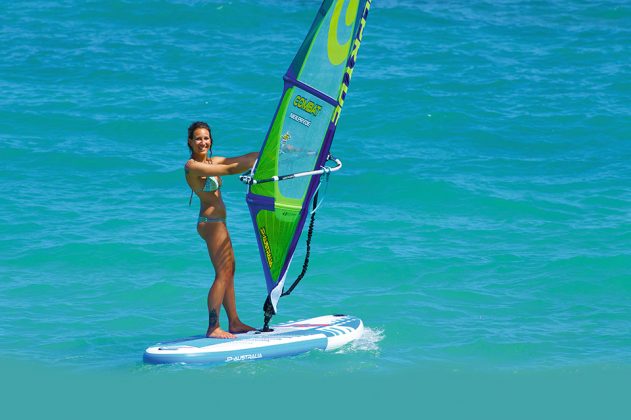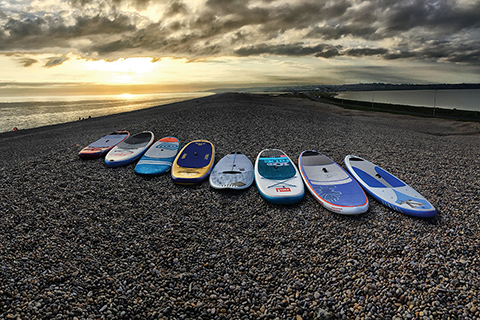THE BEST OF BOTH WORLDS?
WINDSUP BOARD REVIEW 2016
Test Editor Tris Best // Review Team Maurin Rottenwalter, Joe North, Joe Hennessey
Photos Alex Best, Tris Best and Thorsten Indra // Location OTC Portland and Gwithian, Cornwall
With the summer months upon us, bringing the warmest temperatures of the year (writing with fingers crossed is quite difficult!), our attention turns once again to a fast emerging phenomenon on the equipment scene – the WindSUP. A ‘one board does all’ providing fun for all the family. Yet WindSUP is fast becoming a mammoth category, exhibiting such diversity amongst the brands’ offerings that we could actually fill the next few issues of the magazine if we were to implement our usual category testing regime! So instead we’ve asked the brands to provide the WindSUP of their choice – their golden product or bestseller, with a new USP (Unique selling point) or feature that is worthy of note – and charged our test team to review the offerings to give us a true flavour of what is out there on the market. And it has thrown up some really interesting insights … over to Tris and the team at The Official Test Centre (OTC).
This test review was originally published in the August 2016 issue of our sister publication Windsurf Magazine.
WINDSURFING EBBING
Ever since I had my first eye-opening (okay, let’s not be coy about it – life-changing) experience on a windsurf board, I can remember both reading and being told that the sport was on the decline. The heady days of the sport were in the mid-to-late eighties; days that heralded some mystical statistic like every third car on the road having a windsurf board fixed to its roof rack. Boards were being sold in supermarkets and most that entered the sport were by being taught for the first time by their friend or family member. Truth is, I can’t remember it myself as I learnt as a teenager in the mid-nineties, but even back then, I recall article after article in the magazines, countless developments by the brands and initiatives introduced by the sport’s NGB, the RYA, to try and bolster participating numbers. The main problem hindering the sport was easy to identify. When the sport flourished in the eighties, everyone owned a single board – a one-board-does-all. Championed by all brands at the time, it was very likely to be in excess of 365cm in length, made of tough durable plastic and was used to venture out on the sea or lake, whatever the conditions. It could be used for travelling over distances and exploring, raced competitively at club and national level … but most importantly, used to teach friends or family that were also keen to give the sport a go. It helped to pump new blood into the sport as well as keep the existing windsurfer captivated. Yet, as with all things new and competitive (be that the participants competing against each other or against the elements … or young passionate brands competing for their slice of the cake), development was swift – and the quest for performance and sales drove the market’s attention away from the allrounder. So the truth of the matter is that the introduction of the ‘fun-board’ and planing windsurfing in increasingly stronger winds can be linked directly to the downturn of the sport’s growth. Almost every experienced windsurfer traded their longboard in for a short board or sinker – a fun plaything that let them push their boundaries in ever increasing wind strengths … yet severed the ability to teach others. And the practicality of owning two boards and lugging the old faithful battleship around on the roof of the car seemed less appealing. Everyone in the industry could identify the problem and yet the solution to reverse the sport’s fortunes remained elusive. Bold and innovative developments in light wind windsurfing, from one-design racing classes to displacement hulls to reintroducing the longboard-saviour, just didn’t take seem to inspire or take off. Storage, expense, construction dilemma, and practicality … you name it, there were a multitude of reasons that could be attributed. It seemed that the sport had simply moved on … and the only way to stem the flow was to push its learning through schools and centres, whilst continuing development to make the sport easier to learn.
THE FLOW OF SUP
In contrast, the rise of stand up paddling over the past decade or so has taken many by surprise. It seems to be the golden-child of watersports at present and can do no wrong. Indeed, its growth has literally saved many windsurf centres, even brands, from an ominous future.
Most windsurf brands leapt on the opportunity to generate sales in an emerging market and the WindSUP was the logical next step – merging two sports that could compliment each other and, on the face of it, be enjoyed using the same board. It seemed like a stroke of genius … yet the move wasn’t without its fair share of critics. Many saw it as simply a commercial decision, trying to make a quick buck. In a memorable magazine interview back in the ‘mid-noughties’ I recall the figurehead (and ex-World Champion) of a notable windsurfing brand even lambasted his competition in their move into Sup’ing, believing it only served as a distraction, taking attention and development away from our beloved sport of windsurfing. And the early WindSUP boards that emerged seemed to only fuel the fire, the requirements placed on board design by the two sports seeming to contradict each other.
You could include a deckplate insert in any SUP, yet it didn’t make it a true windsurfing board. For example, I recall owning an 8’5” wave-specialist SUP that could be used with a windsurf sail. Fine for use in marginal winds, yet as soon as the wind increased, the board had so much tail rocker (as a normal surfboard would) that it would plough through the water and protest wholeheartedly at the very notion of releasing onto the plane. It had a quoted 125L of volume yet struggled to get going in wind strengths when a 90L wave board would be rising effortlessly onto the plane.
The introduction of inflatable paddle-boards provided a whole new opportunity for ridicule by the purist windsurfing fraternity, helped largely by the emergence of countless far-east manufacturers flooding the market with low quality and poorly shaped designs. How could this ‘executive lilo brigade’ be taken seriously? Well, you better believe it! As with all things, if money flows in sales, the success can be invested to develop designs and concepts more rapidly.
The WindSUPs of 2016 are a far cry from the first WindSUP designs to market. Their shapes show real thought and consideration, whilst their construction, finish and fittings are much more refined than their predecessors. They have become a more complete product. There also seems to be a real understanding emerging on how to develop boards with the demands of both sports in mind. Sure, there will inevitably be some bias one way or the other, but it is now conceivable to have a large volume board that is a lot of fun for the experienced to use (be that in the waves, cruising on a summer’s day, playing at light-wind freestyle … or all of the above but under paddle power) whilst also doubling up as a perfect entry-level tuition platform. So has the answer to dwindling windsurf numbers been found? Could the growth and blossoming of stand-up paddling rub off and benefit windsurfing as well? Anecdotally, retailers and schools report positive signs, which is encouraging to hear.
FINDINGS – HOW DO YOU LIKE YOUR EGGS?
Of the eight boards on review here (reminding you that these were handpicked by the brands themselves), six are inflatable (soft) and only two are ‘hard’ boards, produced using modern sandwich methods. The hardboard will always win out for the more discerning pilot, such as the committed wavehead – those that really want to feel the board’s rails when they bank into a corner. The hard board feels familiar underfoot, sitting reassuringly in the water and acting as you would expect when you shift your weight from foot to foot … or mastfoot. And yet, with evident advances in material, construction and features, the inflatable option is deservedly coming onto the radar, narrowing the gap considerably over the last two or three seasons and in terms of sales, the majority of consumers opt for the inflatable option to date. To compliment the obvious advantages of easy storage and transportation, lighter weight, reduced cost … even improved durability, the inflatable WindSUP can also, crucially, offer advantages in performance over their hardboard counterpart. For example, consider acceleration and response. By packing in considerably more volume size for size, and being full of air, the inflatable sits high in the water, and with their reduced weight will accelerate more readily as power is applied (either through sail or paddle). This can provide real benefit for the progressing windsurfer, whilst for the beginner the major bonus all these particular inflatable WindSUPs possess over and above the hard boards is a central fin. The value and necessity of this simple addition for entry level performance cannot be underestimated, the boards supplied with a larger central fin performing even better still. So what other factors in inflatable technology will influence performance?
INFLATABLE WINDSUP – IT’S ALL ABOUT THE GIRTH
By stepping onto these boards for this review, we believe the biggest single influence on an inflatable WindSUP’s performance is its thickness. As we write this (we have to add the caveat as it seems the WindSUP/SUP design consensus is changing year by year, even month by month at present), there are three drop-stitch thickness options currently available for inflatable board manufacture: 150mm (5.9”) – rounded up as 6”; 120mm (4.75”) – classed by most as 5” and 100mm (3.93”) often referred to as 4”. Comparing these three options, it seems there is a correlation throughout this case study of boards in relation to their girth:
• 4” thick: Sit deeper in the water, offering good manoeuvrability and cope well as the wind increases, yet offer less glide and structural stiffness. A good option for children / lightweight riders.
• 5” thick: Seems to be the optimum thickness for WindSUPs. Best compromise between stiffness, glide, acceleration and control as the wind increases, irrespective of adult rider weight.
• 6” thick: Stiffness is easily achieved at less pressure and the board is a delight to use, windsurfing in light winds or as a SUP, feeling responsive and gliding effortlessly. Yet its performance as a windsurfer diminishes as the wind increases, feeling too corky and vulnerable to the influence of chop, with reduced directional traction.
There are of course other influences on performance (outline, volume distribution, rocker etc), but for true windsurfing capabilities we found boards possessing 120mm thick drop-stitch in their core stole the show.
THE OPTIONS
Of the boards on review here, there are some really interesting features and design USPs worthy of note. The Starboard was a great deal of fun to use by all who tried it, with its rail edge technology really taking its performance in powered conditions to another level. In light, marginal winds, the Fanatic and JP both displayed the advantage of their 6” thickness by providing excellent response and glide, even at minimal pressure. At the other end of the scale, the Vandal’s 4” thickness came into favour with the lighter rider, or those using the board in stronger, choppier conditions. The O’Shea has got to be the first inflatable board we’ve used with a distinct windsurf bias to its performance. It is a great entry-level tutor, with the build and quality to withstand some considerable abuse. That leaves the RED Paddle 10’6” – their number one bestseller SUP that also makes a very natural WindSUP. It works excellently in a windsurfing role … and yet we know they are about to release a new inflatable product with even more innate windsurfing performance. We have tried it … and all we will say is that we’ve ordered some for the OTC windsurfing school!
So does the ascendency of the inflatable WindSUP signify the end of the hardboard? Not on your nelly! The Quatro is a beautifully crafted board – compact, responsive and wonderfully crisp in the turn, its mega width making its performance easily accessible. The Nah Skwell is an allrounder, with a classic feel for all the family to enjoy and the durability to withstand such diverse use. So the betterment of the inflatable WindSUP has in effect made the hardboard become more of a niche product for the acute and demanding rider.
One thing for sure is that this sector of the windsurfing market is undoubtedly going to continue to evolve and develop for the better. With Arrows entering the fray last autumn with their inflatable iRig … and following it up this month with their ‘Drift Stopper’ strap-on central fins and ‘Adaptor Strap’ deckplate option (so that any SUP can be converted to become a WindSUP), there is certainly a lot of lateral thinking going on. You may scoff at the very thought of using such items, but if it encourages people into windsurfing through being taught by their friends this summer then the cycle is complete and the critics will be all but silenced.
*** The RRD windsup arrived too late for inclusion in above write up for print but is now included in the links below ***
THE LINE UP
STARBOARD WINDSUP INFLATABLE 11’2” ZEN



